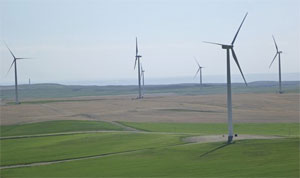Wind developers have long struggled with how to prevent birds – especially eagles and hawks – from crashing into turbines, and a solution may be at hand thanks to efforts at Montana’s largest wind farm.
126 wind turbines comprise the 189 megawatt Rim Rock Wind Facility that’s spread across 21,000 acres. By today’s standards, the turbines are small at 1.5 megawatts each.
When NaturEner USA developed the project, which at peak production supplies 60,000 homes, it worked with the local Audubon group to site turbines as far as possible from raptor nesting sites.

But it’s been a combination of human observers and radar tracking cameras that "provides the best kind of protections that have been deployed anywhere in the US," Greg Copeland, vice president of wind energy development told Associated Press.
Protecting raptors is being put to the test because the wind farm is near sandstone cliffs – prime habitat, where eagles and hawks nest in rocky outcroppings.
Since Rim Rock started operating late last year, only two raptors have died – a tiny number compared to typical wind farms.
How They Do It
Human observers – trained avian biologists – scan the skies from three locations throughout the day using high resolution spotting scopes.
Combined with radar tracking cameras, they can detect raptor flight patterns as far as 1200 miles away. When a likely collision is identified, they alert the San Francisco operations center to shut down turbines, which can be done in as little as 30 seconds.
That isn’t a problem for power output because the wind farm is divided into zones, each with 4-8 turbines. When a shut down order is given, it applies to a particular zone, allowing the majority to keep operating. And shut down times range from 3- 30 minutes.
Rim Rock has had much more success using radar because it places the detection system outside the wind farm instead of in the interior, as most other developers do (which causes interference).
If raptors somehow get past the radar and human "biomonitors," there’s a last line of defense – cameras mounted on turbines. The cameras have software that visually tracks raptors and if a bird flies within 200 meters of a turbine, it triggers a high frequency noise and flash of light that drives them away.
Finally, during times of year when wind patterns tend to push birds toward certain turbines, the company proactively shuts them down ahead of time and keeps them that way until the wind shifts.
Copeland calls this a "layered approach" and credits it as the key to successfully avoiding bird collisions. Through all this monitoring they have found that raptors are on the wind farm’s footprint only about 10% of the time.
Copeland estimates the cost for buying and maintaining the radar units at about $750,000 over 5-10 years. That may seem like a lot of money, but it’s worth it, he says, because they are a green company that cares about wildlife. And it also keeps potential regulation at bay.
Wind turbines generally kill fewer birds these days than older versions of the technology because blades are much larger and move more slowly. Still, at their tips they can turn at 200 miles per hour. Raptors are looking down for food, they don’t expect a huge airborne object to strike them, Steve Hoffman, Executive Director of Montana Audubon told Great Falls Tribune.
More Difficult for Bats
Because bats are so small and fly at night, it’s much harder to protect them from collisions – which happen at just about all wind farms.
In addition to colliding with turbine blades, they can be traumatized by changes in air pressure created as they turn.
Well over 600,000 bats are killed by turbines every year, according to research by Mark Hayes at University of Colorado, Denver. Other researchers believe it’s as high as 880,000 deaths. Bat deaths are highest in the Appalachian region, says Hayes.
He believes a solution will be found for bats. Research is underway on sounds that may deter bats from turbines; another solution could be closing down turbines during times when bats are found to be most active.
Both raptors and bats are of particular concern because of their low fertility rates, giving birth to just one offspring a year. And bats are being further decimated by white nose syndrome.
The Bats and Wind Energy Cooperative has been working on ways to help bats for years. The alliance consists of Bat Conservation International, the American Wind Energy Association (AWEA), the U.S. Fish and Wildlife Service and National Renewable Energy Lab.
Studies are also underway to track the flight patterns of marine birds that could collide with offshore wind turbines.

